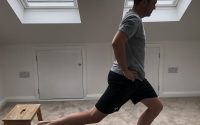5 Ways to Increase Dorsiflexion
Happy New Year Everyone.
Having had a couple of weeks off writing I decided to start the New Year off with a BANG…so here is the most popular post I’ve ever written!!!! Hope you enjoy it 🙂
So here are 5 ideas that I use in my clinic every day:
- Sub-talar mobs
There are many different sub-talar mobs and I always start with these as you get the most ‘bang for your buck’. Ankle dorsiflexion is often limited by a stiff sub-talar joint, so getting this moving will often free up the ankle to take advantage of dorsiflexion.
My STJ mob of choice is as follows. With the patient in supine and you sitting on the affected side, rest the patients lower leg on your thigh to get the foot free off the couch. Then use your inside hand to ‘pin’ the talus so you can mob the STJ via a transverse plane rotation of the calcaneus with the other hand. Simple as that! It’s really effective, really easy and can be done in a very short time and then re-test.
2. Eversion with a fibular glide
If the above mobilisation has limited effect, I move on to this one. Often, if there has been ankle fractures/sprains the distal tib/fib joint can be stiff. With the patient supine and their leg flat on the couch, I glide the lateral malleolus with my thenar eminence and use my other hand to drive sub-talar eversion. Sometimes I hold the fibular glide, sometimes I oscillate, depends on what you feel as the treatment progresses.
This is a little more aggressive, but works if the joint is particularly stiff. Once I’ve freed this up I will then go back to the above sub-talar mobs as they may now be more successful. However, after that it is vital that you challenge this new range in functional movement, which are covered in 3, 4 and 5.
3. Dorsiflexion matrix
This is one of my favourite exercises as it integrate end range dorsiflexion, while getting the whole body involved, particularly the same side hip extension.
Start Position
You start in the traditional calf stretch position, as if you were trying to push a wall over, with the affected side back.
Sagittal Movement
Pick the opposite leg up and drive it towards the wall in the sagittal plane, I usually repeat that at the patients chosen pace for about 10-15 reps.
Frontal plane
From the same position, drive the opposite side foot forward and left and back, then forward and right and back. This brings in a bit more sub-talar motion, while still really driving that dorsiflexion.
Transverse plane
Pick the opposite side knee up so the hip is at 90 degrees, then swing the knee left and right to get the pelvis rotating in the transverse plane. This sends lots of top-down transverse plane motion through the foot and really drives the foot.
4. End Range Squat Matrix
This is a great non-aggressive and really functional way to get dorsiflexion, which I often use in later treatment sessions when I’ve done most of the hard work and just need to get things are moving again at the start of the treatment.
You can position the feet in the normal squat position, or tweak the position to better suit the individual patient.
Ask the patient to squat to their end range, then with their hands above their head drive 3 planes of motion with bi-lateral hands. Simple, but amazingly affective and is perfect to get motion quickly before progressing the treatment.
5. BAPS Board
This is a great but of kit. I personally have an Air BAPS. If you’ve not seen one, it’s like an offset balance board, however, it is also so much more! The outer edge of the board is designed to mobilise the ankle, creating range in the different joints in the foot and ankle complex.
As you can see from the picture it has different angulations, so you can use the board to work on different foot motions…genius!! It’s really useful as it’s non aggressive, but very effective and the patient has control. I get the patient to roll around the edge of the board 10-15 times clockwise and then the same anti-clockwise, then re-test. You’ll feel like your walking on air when you’ve finished.
Summary
These are just a few ideas and should only be used when appropriate for you individual patient, I personally only get my patients to complete exercises that are pain free for them.
Hope this has been of interest, if you have any strategies you would like to add feel free to add to the comments below.
Physioblogger


